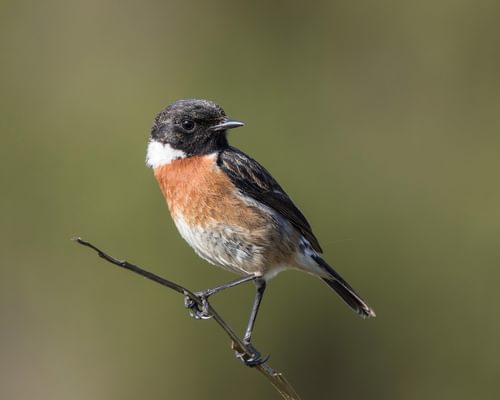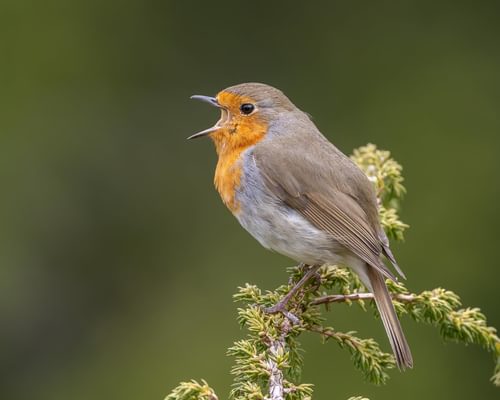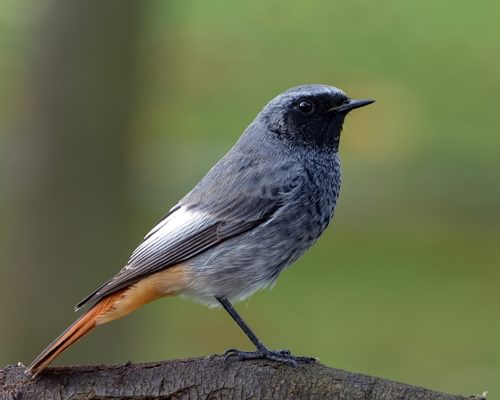Common Redstart
Least ConcernPhoenicurus phoenicurus
Visual Identification
Appearance
The Common Redstart is a small, slender bird with a distinctive orange-red tail that it frequently quivers. Males sport a striking black face, white forehead, and blue-grey upperparts, contrasting with their vibrant orange-red breast and flanks.
Females and juveniles are more subdued, with brown upperparts and a pale buff breast. Both sexes retain the characteristic orange tail, though it's slightly duller in females and young birds. Females also have a narrow, white ring visible around the eye.
Size
Length
13cm to 14.5cm
Wingspan
20cm to 24cm
Weight
11g to 23g
Habitat and Distribution
Habitats
Woodland
Garden
Wetland
Coastal
Urban
Farmland
Grassland
Desert
Tundra
Rainforest
Mountain
Savanna
Distribution
Common Redstarts inhabit open woodlands, forest edges, parks, and gardens across Europe and western Asia. They prefer areas with a mix of mature trees and open ground for foraging.
These birds are summer visitors to most of their breeding range, including the UK, where they arrive in April and May. They spend winters in sub-Saharan Africa, making them true long-distance migrants.
Wales and northern England are particular 'hotspots' for breeding Redstarts, with other breeding populations in north-west Scotland as well as isolated spots across south-western England.
Elevation Range
Up to 2,900 meters
Climate zones
Temperate, Subarctic, Mediterranean
Distribution Map
This map gives you a rough idea of where you might spot a Common Redstart. The coloured areas show countries where these birds have been seen.
A few things to keep in mind:
- Birds might not be everywhere in the coloured areas, for example, they may be present around the coast of that country
- Where birds live can change with seasons and available food
- This map is quite simple - it doesn't show exact locations
We're working on making our maps even better! Soon, we hope to show you:
- More detailed maps for bigger countries, including state and region
- How birds move around during different seasons
Distribution by Region
Behaviour and Ecology
Bird Attributes
This feature is in beta. We'd love your feedback to improve it!
Share your thoughtsBird Attributes Explained
Our bird attributes system rates various aspects of a bird's capabilities on a scale of 0-100, based on data from field observations, scientific studies, and expert knowledge.
Attribute Categories:
- Agility: Manoeuvrability, speed, and grace in flight or movement.
- Strength: Physical power, often correlating with size and hunting abilities.
- Adaptability: Ability to thrive in various environments or changing conditions.
- Aggressiveness: Territorial behaviour and assertiveness, particularly during breeding seasons.
- Endurance: Stamina, often seen in migration patterns or foraging behaviours.
Understanding the Ratings:
- 0-20: Very Low
- 21-40: Low
- 41-60: Average
- 61-80: High
- 81-100: Very High
Remember, these attributes are relative to other bird species and don't necessarily indicate superiority.
Hover over the icon next to each attribute for more information.
Tap the icon next to each attribute for more information.
Agility
Reflects the bird's manoeuvrability, speed, and grace in flight or movement.
The Common Redstart displays remarkable agility, with quick, darting movements and frequent perch-to-perch flights. Their ability to swoop and catch insects mid-air, coupled with their restless nature and tail-quivering behaviour, indicates high manoeuvrability and reflexes.
Strength
Indicates the bird's physical power, often correlating with size and hunting abilities.
As a small passerine bird weighing between 11-23 grams, the Common Redstart has limited physical strength. While capable of long-distance migration, their strength is more focused on endurance rather than raw power.
Adaptability
Represents the bird's ability to thrive in various environments or changing conditions.
Common Redstarts show good adaptability, inhabiting various environments from woodlands to urban gardens across a wide elevation range (up to 2,900 metres). Their ability to supplement their insect diet with berries and their capacity to nest in diverse locations, including artificial nest boxes, demonstrates flexibility.
Aggressiveness
Measures the bird's territorial behaviour and assertiveness, particularly during breeding seasons.
While not overtly aggressive, Common Redstarts do exhibit territorial behaviour, particularly during breeding season. Males defend small territories and perform display flights, but they are not known for excessive aggression towards other species or conspecifics outside of normal breeding behaviour.
Endurance
Reflects the bird's stamina, often seen in migration patterns or foraging behaviours.
The Common Redstart's long-distance migration from Europe to sub-Saharan Africa showcases impressive endurance. Their early departure in autumn and ability to complete such extensive journeys, coupled with their active foraging behaviour, indicates high stamina and resilience.
Diet
Common Redstarts primarily feed on insects and spiders, which they catch by swooping from a perch or sometimes gleaning from vegetation. Sawflies, ants, wasps and hoverflies are among the chief prey.
During autumn, they supplement their diet with small berries and fruits, especially before and during migration.
Flying insects may also be caught using the ‘sallying’ technique, with male redstarts in particular observed to catch prey mid-flight by hovering or fluttering in pursuit of flies.
Behaviour
Common Redstarts are agile and restless birds, often seen flitting from perch to perch with quick, darting movements. They frequently bob their distinctive orange tails and flick their wings.
These birds are generally solitary outside the breeding season, defending small feeding territories.
Vocalisation
The Common Redstart's song is a short, sweet warble, often ending with a flourish. It's described as 'hueet-tick-tick' or a soft whistle followed by a rattle. Their alarm call is a sharp 'huit' often accompanied by tail-flicking.
Males sing prominently during the breeding season, often from exposed perches.
Nesting & Breeding
Breeding occurs from May to July, with males arriving at nesting sites before females to establish territories. Males perform display flights and sing to attract mates.
Nests are typically built in tree holes, wall crevices, or nest boxes, constructed mainly by the female using grass, moss, and feathers. The clutch usually consists of 5-7 pale blue eggs, sometimes specked with red-brown markings.
Incubation lasts about 13-14 days, primarily by the female. Both parents feed the chicks, which fledge after 12-15 days but remain dependent on adults for another two weeks.
Lifespan
The Common Redstart typically lives for 2 years, with a maximum recorded lifespan of 10.2 years.
Like all birds, lifespan can be affected by factors including predation, habitat quality, disease, and access to food sources.
Conservation and Status
Global Conservation Status
While listed as Least Concern globally, Common Redstart populations have experienced declines in parts of Europe.
Conservation efforts focus on maintaining suitable breeding habitats, particularly in managed woodlands and parklands. Climate change and habitat loss in wintering grounds are ongoing concerns.
Birdwatching Tips
- Look for their distinctive tail-quivering behaviour
- Listen for their soft 'hueet' call and melodious song
- Search in open woodlands, parks, and gardens, especially near the edges
- In the UK, watch for them during spring and summer in suitable habitats
Additional Information
Quick Facts
Other names:
European Redstart, Redstart
Family:
MuscicapidaePredators
Common Redstarts face predation from various birds of prey, including sparrowhawks and merlins. Ground-nesting pairs are vulnerable to mammalian predators such as foxes and weasels.
Did You Know?
- Common Redstarts can imitate the calls of other bird species in their song.
- They are one of the earliest migrants to leave Europe in autumn, often departing in August.
- The name 'redstart' comes from the Old English for 'red tail'.
Was this bird profile helpful?
Your feedback helps us improve our content
Thanks for your feedback!
Your input helps us improve our content.
Community Experience
Community Ratings
No ratings yet - be the first to rate this bird!
Latest Community Reviews
No reviews yet
Sign in to be the first to review
Community Reviews
Create Your Free Account Welcome Back!
Join our community to rate birds and share your experiences. Creating an account is completely free and only takes a minute. Sign in to your account to rate birds and share your experiences with our community.
Your information is secure and will never be shared.
By creating an account, you agree to our Privacy Policy.
FAQs
How to attract Redstarts?
In the absence of natural tree hollows, redstarts will occasionally set up home in a manmade nest box, and one way to make your garden as appealing as possible is to encourage a wide variety of insect life for them to forage on.
Planting a mix of insect-friendly plants and flowers and leaving weeds to grow wild may bring you some success in attracting Redstarts.
Redstart sightings are increasingly being reported in urban areas, such as parks and residential areas, so it is not impossible for breeding redstarts to nest in a back garden in the regions in which they are most widespread.
Similar Birds
References
- 2 3
website: BirdLife International. 2019. Phoenicurus phoenicurus (amended version of 2016 assessment). The IUCN Red List of Threatened Species 2019: e.T22710055A155611852.
View source - 4
report, 2015: EBCC
- 1
website, 2010: Fransson et al., EURING list of longevity records for European birds
View source


